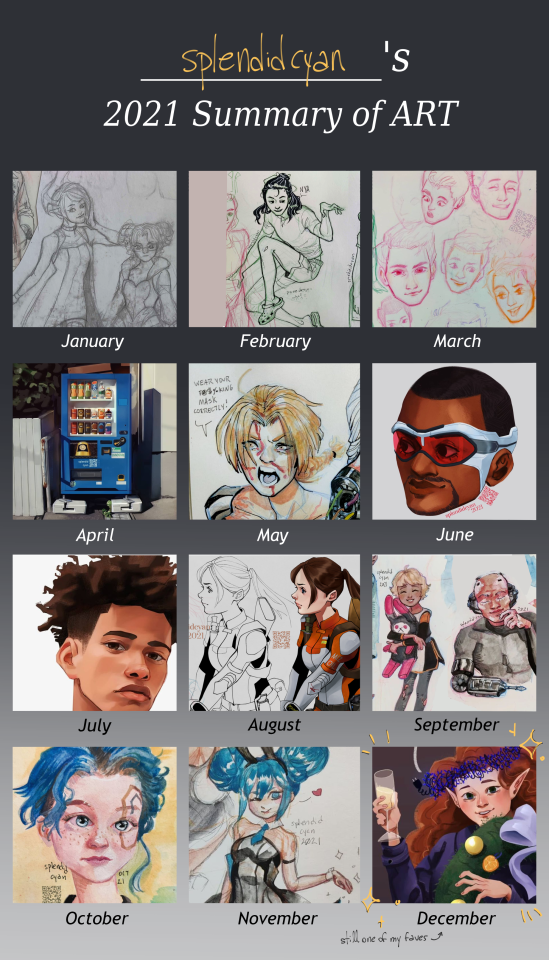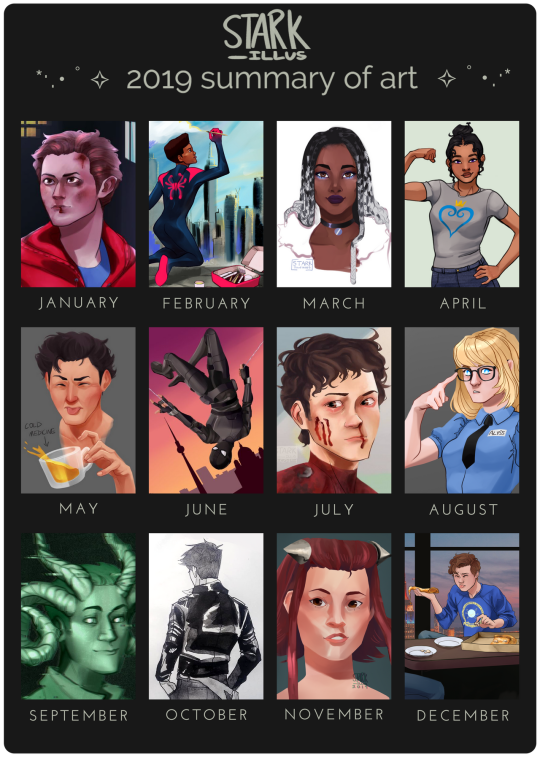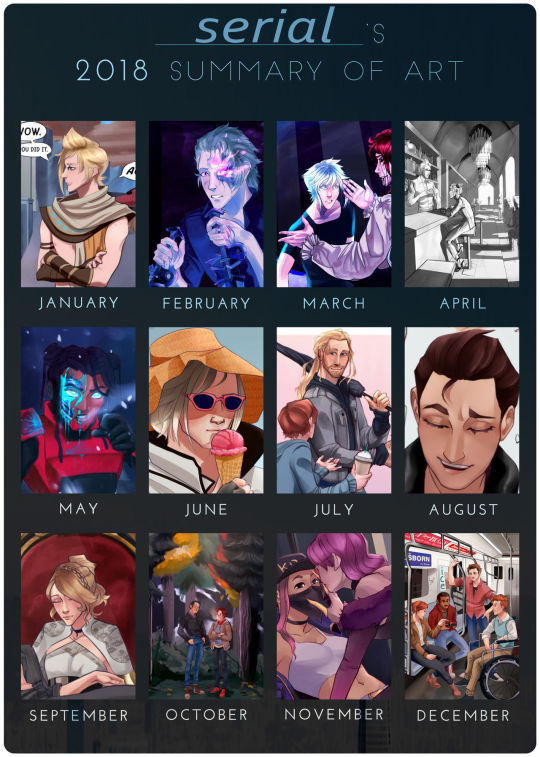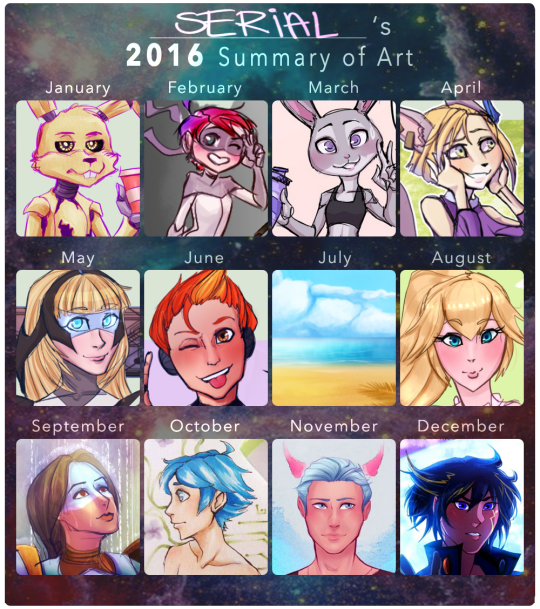#ITS SO FUNNY that I used a watercolor texture to back up the 2017 one and yet I didn't pick up a brush to paint regularly until 2020 lol
Explore tagged Tumblr posts
Photo









A decade of art (and also the entirety of my teen years)!
I was only intending to put together my 2022 summary of art, seeing as I hadn’t made that yet-- and then found I also hadn’t made my 2021 summary, and fell down a rabbit hole of nostalgia from there :)
It’s interesting how as I progress as an artist, I’m less and less repulsed by my “old“ work-- like my December 2021 piece is STILL one of my favorites, and one I try to keep up with sorta. And yet, on the flipside, things I know I was proud of last year, two years ago, I’d do so much differently now. My idea of “good” art is different every year-- for a lot of the late teens I REALLY wanted to be an MCU concept artist so realism was what I strove for. But nowadays I’m really embracing simplification in ways I know I never could have before. I talked to my illustration professor about this, and he said something along the lines of, “It’s okay that it took you this long for it to click-- that’s why there’s four years of schooling.” I’m graduating in a few months and there’s still so much I don’t understand and I still feel a lot like the 12 year old using a mouse and GIMP/Paint.NET vector paths to draw. The nice part about still feeling like a kid, though, is that it’s still so much fun to do :)
#2022 summary of art#summary of art#my art#2022#2021#2020#2019#2018#2017#2016#2015#2014#2013#2012#four usernames and like half a dozen art programs and countless colored pencils and printer paper haha#ITS SO FUNNY that I used a watercolor texture to back up the 2017 one and yet I didn't pick up a brush to paint regularly until 2020 lol
11 notes
·
View notes
Text
Reading Log 2
Wordless picture books:
Flotsam
By David Weisner
Clarion Books, 2006
40 pages
Ages: Pre-K – 3
Awards: The Caldecott Medal
Flotsam is a wordless picture book that follows a young boy as he finds “flotsam” on the beach. When he finds an antique camera, the boy brings the film to a one-hour photo processing (although many children today might not be familiar with the concept of one hour photos, or film for that matter). The developed pictures show a fantastical ocean world. There is also a photograph of pictures-within-pictures, for which the child uses a microscope to figure out the first child photographed. Having photographed himself holding the pictures-within-pictures, he sends the camera back into the ocean.
The watercolor illustrations blend fantasy and realism. The underwater photos are painted in colors a bit bolder than the rest of the story, which sets them apart and adds a sense of mystery. The book’s design, using two-page spreads as well as comic-style panels, help to pace the story and give it motion where necessary.
Books about sea-life and the ocean always make for excellent summer reading. This book is great for sharing between an adult and child, prompting conversation with and about the book. Children will enjoy this visual story about a realistic excursion that turns into a wondrous experience.
Once Upon a Banana
by Jennifer Armstrong; illustrated by David Small
Simon & Schuster Books for Young Readers, 2006
48 pages
Ages: 4-8
Awards: ALA Notable Children’s Books, Kirkus Editor’s Choice, NCTE Notable Children’s Books in the Language Arts (Simon & Schuster, 2017).
This (mostly) wordless picture book is about the havoc created due to a misplaced banana peel. This story is reminiscent of slap-stick comedy as a biker slips on a banana peel, setting in motion a series of accidents that result in a whole truckload of bananas spilling all over the street (one can’t help but wonder if the author was inspired by Harry Chapin’s 30,000 Pounds of Bananas). The artist’s watercolor technique and sketched lines lend to the chaos of the story. The frenzy of the illustrations is tempered by the rhyming street signs, such as: “Please put litter in its place” and “No parking in this space.” This is a storybook that children can enjoy many times over, because there is so much to see in the illustrations. While it could be used for curriculum support in discussing consequences, it is also an enjoyable bonding experience to try and figure out together everything that is happening in the book.
Picture books not originally published in the United States:
Polo: The Runaway Book
By Regis Faller
Roaring Book Press, 2005
80 pages
Ages: [4 - 8]*
This is a wordless picture book originally published in France. Polo receives a new book, only to have it stolen by a strange creature. We follow Polo on a grand adventure as he tries to rescue his book. He takes us through a world made of cotton candy, one made of yarn, a jungle, a desert, and a world made of clouds, only to find that the strange creature has taken the book to read it to his friends. Polo makes his own assortment of friends along the way, including the creature who stole his book, who meet up in the end around his tree house. The final picture of Polo fast asleep leads the reader to wonder, was this adventure all a dream?
This story is told through visual images in comic book style panels. The artist’s use of cartoon illustrations and bright colors brings the reader into this fantastical world. The use of complementary colors - blues and greens for the backgrounds - keep the reader’s eyes on Polo and the book, both in an orangey shade of red. The prevalence of curved lines provides a sense of movement across each page and throughout the book. This is a great story time book to be shared and discussed between caregiver and child. Children will delight at Polo’s adventure and the new friends he meets along the way.
The Rainbow Fish
by Marcus Pfister; translated by J. Alison James
North-South Books Inc., 1992
25 pages
Ages: [2-8]
Awards: The Christopher Award, Bologna Book Fair Critici in Erba Prize, American Booksellers Association ABBY, IRA-CBC Children’s Choice Title (North-South Books, 2012).
Originally published in Switzerland, this picture storybook follows the rainbow fish as he learns that beauty is not enough to make friends. An octopus in a cave teaches him that friendship requires selflessness as he shares his most prized possession - his beautiful scales - with the other fish. The artist’s use of glittery foil-stamping sets the rainbow fish apart from the other sea creatures in the book, as the foil scales contrast with the blurred watercolor textures of the illustrations. The author uses questions to verbally illustrate the rainbow fish’s character development throughout the story, but they also function to hold the reader’s attention. This is an excellent summer reading choice for early readers or story time choice for pre-readers to share with adults. Children will be intrigued by the glittery scales that shimmer as the pages turn, while adults will appreciate the moral lesson of the story.
Alphabet Books:
Chicka Chicka Boom Boom
By Bill Martin Jr. and John Archambault; illustrated by Lois Ehlert
Simon & Schuster Books for Young Readers, 1989
36 pages
Ages: 1-4
Awards: ALA Notable Children’s Books, Biennale of Illustrations Bratislava, Boston Globe/Horn Book Award Honor Book (Simon & Schuster, 2017)
An alphabet book for beginning readers, Chicka Chicka Boom Boom is a funny story about the letters of the alphabet climbing a coconut tree and then falling down because the tree can’t hold them all. The author uses rhyme and repetition to create a song-like rhythm in the story, while nonsense words to add a sense of whimsy. The book is illustrated in boldly painted, simple geometric shapes, which make it easy for young children to visually follow the story.
Chicka Chicka Boom Boom makes perfect curriculum support for children learning the alphabet. This book begs to be read aloud and children will have a blast saying, “Chicka chicka boom boom! Will there be enough room?” This line creates tension in the story as the reader wonders: how will the coconut tree hold them all? And it is great fun to shout, “Oh, no!” as the letters fall down.
Once Upon an Alphabet
By Oliver Jeffers
Philomel Books (Penguin Group), 2014
112 pages
Ages: 3-5
This is an alphabet book made up of short stories for each letter of the alphabet. Each letter has an introduction page that includes that letter and the story’s title, all in the color theme for that particular story. The author uses alliteration and the occasional rhyme. The stories are very funny and whimsical, which is especially effective for the more awkward letters of the alphabet (i.e. X and Z). The illustrations are mostly monochromatic ink drawings, with splashes of color to draw attention the each story’s subjects. For example, in “J: Jelly Door,” the J and the door are both painted a bright shade of pink. Since the stories a very short, just a few paragraphs each, the illustrations help to show parts of the story not explicitly stated.
I would argue that this book is more appropriate for the enjoyment of independent readers rather than for younger children learning the alphabet. The stories and illustrations are a lot of fun, but the correlations between letters and stories aren’t always simple enough for younger children to pick up on. This book would make a great writing assignment prompt for older children.
* Where age ranges are bracketed, that information could not be found in the book or on the publisher’s website, so I offer an estimate.
Resources:
Horning, K.T. (2010). From Cover to Cover: Evaluating and Reviewing Children’s Books (revised ed.). New York: HarperCollins.
North-South Books (2012). “The Rainbow Fish,” retrieved from http://www.northsouth.com/the_rainbow_fish
Simon & Schuster (2017). “Chicka Chicka Boom Boom,” retrieved from http://www.simonandschuster.com/books/Chicka-Chicka-Boom-Boom/Bill-Martin/Chicka-Chicka-Book-A/9781442450707
Simon & Schuster (2017). “Once Upon a Banana,” retrieved from http://www.simonandschuster.com/books/Once-Upon-a-Banana/Jennifer-Armstrong/9780689859519
Vardell, S.M. (2014). Children’s Literature in Action: A Librarian’s Guide (2nd ed). Santa Barbara: Libraries Unlimited.
1 note
·
View note